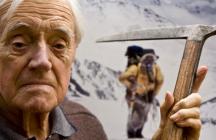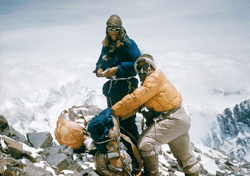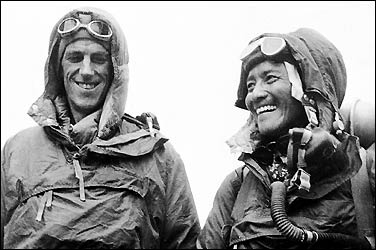Yeti Tracker Dies
Posted by: Loren Coleman on February 10th, 2010

Alfred Gregory with ice ax he used on the 1953 Mt. Everest acsent. Photo: The Age by Joseph Feil.
| The June 13, 1955 issue of Sports Illustrated contains an survey article about recent sightings of the Yetis of the Himalayan area. It begins with this breaking bit of news, before giving a general review of other accounts:
“Last week Alfred Gregory, leader of an expedition in the Menlung region of Nepal, reported seeing tracks at 18,000 feet which appeared to have been made by an Abominable Snowman.” |
Now word comes that Gregory has died.

Photo by Alfred Gregory.
Ed Hillary and Tenzing Norgay en route to highest camp at approximately 28,000 feet, 8500 meters. 1953
On May 29, 1953 Sir Edmund Percival Hillary and Sherpa Tenzing Norgay made history when they climbed Mt. Everest. Alfred Gregory took the photos of the two that went around the globe.

Alfred Gregory: Official photographer on the 1953 Everest expedition
Wednesday, 10 February 2010 The Independent
Alfred Gregory was official photographer to the British expedition which made the first ascent of Everest in 1953. He joined the team on the strength of his climbing, as well as his camera skills, and on the eve of Hillary’s and Tenzing’s historic climb he carried a load to Camp Nine, which was perched precariously 8,424 metres above sea level, higher than any person had camped before.
Greg, as he was universally known, liked occasionally to point out the differences between the predominantly upper middle class, public school milieu of the 1953 team and what he described as his working class background. In fact, his father owned a successful grocery business in Blackpool. Nevertheless, Greg’s childhood was quite tough, as his father was killed in the First World War, when Greg was only three, leaving his mother to bring up the children alone while struggling to keep the grocery business afloat through the Depression.
On leaving school Greg was apprenticed into the printing trade but he managed, with the help of the new Youth Hostel Association, to escape regularly to the hills, first bicycling, then taking up hill-walking and climbing. By the outbreak of the Second World War, when he was 26, he had managed to travel abroad for three alpine seasons.
During the War he served with the Black Watch in North Africa and Italy. Despite rising to the rank of major, he was delighted to see his war end early with the successful conclusion of the Italian campaign. Free to roam in 1945, he spent a happy summer climbing among the deserted summits of the Alps. In 1946, after demobilisation, he set up his own travel business, specialising in guided alpine climbing. He got to know many local alpine guides, such as the famous Chamonix star, Louis Lachenal, but it was only in 1952 that he was invited by R.L.G. Irving, the Winchester schoolmaster who had introduced George Mallory to mountaineering, to join the Alpine Club.
This venerable London institution, founded by pioneering amateurs in 1857, was still, according to Greg, wary of professionals in 1952: “it was almost impossible to join the AC if you had the stigma of ‘guide’, so I had to keep very quiet about that.” Guide or not, his experience was valued by the establishment and that summer he was asked to join Eric Shipton’s expedition to Cho Oyu.
Cho Oyu was really a training exercise for Everest. The previous year Shipton’s reconnaissance had discovered a possible new southern route up the world’s highest peak from Nepal, but the Swiss meanwhile had booked the mountain for 1952. By way of consolation, the British were given the sixth highest peak Cho Oyu. They made little impression on this objective, as the only feasible route lay in Chinese-occupied Tibet; instead they enjoyed a feast of exploration, roaming wide over the then untrodden wilds of the Nepalese frontier, crossing passes and climbing numerous smaller peaks. They also carried out invaluable physiological research. And they welded themselves into an effective high altitude team, just hoping that the Swiss would fail on Everest that year, leaving the prize open for 1953.
The Swiss did fail, narrowly, and in the autumn of 1952 planning started for a British and Commonwealth attempt in 1953, with Brigadier John Hunt appointed as leader in a surprise – and initially resented – replacement for Eric Shipton. Greg was a natural choice for the team and when it came to his special responsibilities, as he recalled, “John Hunt looked around and said, ‘Now who knows a bit about photography? Ah – Greg seems to take good pictures.'”
Greg was already a keen amateur photographer with his own Contax 35mm camera. Promoted to official expedition photographer, he went to see Karl Maydens, one of the leading photojournalists of the day, at Life magazine. Maydens gave him another Contax and asked Greg what lenses he would like. ‘I said I’d have a 50mm and a 125mm lens. No wide angle! I just didn’t appreciate how big these mountains really were. Still, I think I managed OK.” In addition to that modest equipment, he took a medium format Rolleiflex and two lightweight fixed lens Kodak Retina 2 cameras for use above 8,000 metres.
And that was it. None of these cameras had a built-in exposure meter, so at first all his exposures were calculated with a separate Weston Master meter. However, he quickly learned to judge the dazzling high-altitude light and soon found that he could predict exposure perfectly without the meter. He also didn’t bother with bracketing – hedging bets with multiple incrementally varied exposures – so shot a fraction of the film which would be used on a modern expedition.
The results of this crash course in professional photography include some of the 20th century’s most evocative images: goggled Sherpas balancing heavily laden across ladders spanning immense crevasses; baggy-trousered Charterhouse schoolmaster Wilfrid Noyce leading another heavily-laden team up the silent white valley of the Western Cwm; Hillary and Tenzing smiling triumphantly with enamel mugs of lemonade, safely down after their triumphant climb; and, three days earlier, the classic shot of the two men, on their way up, heading for that ledge where they would sleep higher than any man had slept before.
Hillary carried over 60lb of oxygen and equipment on the final leg to that top camp at 8,424 metres and Tenzing was almost as heavily burdened; the summit pair could never have established the camp without additional help from Ang Nyima, George Lowe and Alfred Gregory. In later years Hillary would grumble testily that Greg was a shirker, reluctant to pull his weight. However, on the day when it really mattered, 28 May 1953, Greg carried his vital load and took his photos. For the only member of the team other than Hunt to have passed his 40th birthday, it was a fine effort.
Everest consolidated Greg’s photographic talent: as he put it later, “I went to Everest an amateur and came back a pro.” Kodak took him on as a freelance lecturer and he packed halls for 20 years. He broadened his horizons, taking on new projects such as photographing the life of his old home town, Blackpool, with one of the first Nikon single lens reflex cameras. He also consolidated his travel business, now called Alfred Gregory Holidays, leading clients year after year on treks through Nepal and other mountainous areas.
He also led two serious mountaineering expeditions. The first, the 1955 Merseyside Himalayan Expedition, continued where Eric Shipton had left off in 1952, mapping the Rolwaling region to the west of Everest, and climbing 19 summits, including Parchamo, nowadays a popular objective for commercial treks. The other expedition, in 1958, was an attempt on Distaghil Sar, one of the highest mountains in the Karakoram range of northern Pakistan, which was unsuccessful due to excessive avalanche risk.
Greg never retired. Travel, adventure and photography remained lifelong passions, shared with his wife Sue, who he insisted was the better photographer. For many years their base was the Derbyshire village of Elton, where guests were always welcomed with an “Eltonian” – a generously strong gin cocktail of Greg’s devising. Then in 1993 they emigrated to Australia to explore a whole new continent, developing a particular passion for the aboriginal rock art of Western Australia. Although Greg never rested on his laurels, and was always seeking new inspiration, he did remain proud of the part he played on Everest, and in 2003, at the age of 90, he was pleased to see his Everest photos exhibited to great acclaim at London’s National Theatre.
Stephen Venables
Alfred Gregory, mountaineer and photographer: born Blackpool 1913; married Suzanne; died near Melbourne 9 February 2010.
I have been unable to locate any images of the footprints that Alfred Gregory found in 1955 that may have been of a Yeti or Yetis.
About Loren Coleman
Loren Coleman is one of the world’s leading cryptozoologists, some say “the” leading living cryptozoologist. Certainly, he is acknowledged as the current living American researcher and writer who has most popularized cryptozoology in the late 20th and early 21st centuries.
Starting his fieldwork and investigations in 1960, after traveling and trekking extensively in pursuit of cryptozoological mysteries, Coleman began writing to share his experiences in 1969. An honorary member of Ivan T. Sanderson’s Society for the Investigation of the Unexplained in the 1970s, Coleman has been bestowed with similar honorary memberships of the North Idaho College Cryptozoology Club in 1983, and in subsequent years, that of the British Columbia Scientific Cryptozoology Club, CryptoSafari International, and other international organizations. He was also a Life Member and Benefactor of the International Society of Cryptozoology (now-defunct).
Loren Coleman’s daily blog, as a member of the Cryptomundo Team, served as an ongoing avenue of communication for the ever-growing body of cryptozoo news from 2005 through 2013. He returned as an infrequent contributor beginning Halloween week of 2015.
Coleman is the founder in 2003, and current director of the International Cryptozoology Museum in Portland, Maine.









